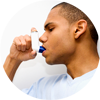OSHA Recordable Injuries
In this webinar, you will learn about:
- What constitutes a recordable injury or illness under the OSHA standard
- Six instances when an injury or illness must be recorded
- When to exclude an employee’s name from the OSHA log for privacy reasons
- Determining OSHA recordability using an easy flow chart
Presented by:
Janet Cobb, MD and Jim Waugh, PT, MPT
Host
0:00
Hello, and welcome to the Concentra webinar, OSHA Recordable Injuries. Today’s webinar will be presented by Dr. Janet Cobb and Jim Waugh, physical therapist. Dr. Cobb is a Concentra director of medical operations. She has more than 20 years of experience in occupational medicine and is board certified in internal medicine. Jim is a Concentra director of physical therapy. He has more than 15 years of experience in providing physical therapy in occupational health settings. Jim is a member of the Workers’ Compensation Research Institute’s Texas Advisory Committee.
At the conclusion of the presentation, we will have a 10-to-15 minute Q and A session with Dr. Cobb and Jim. You can submit your questions throughout the presentation, to be answered during the Q and A. Dr. Cobb and Jim will answer as many questions as possible within the time allowed. A recording of the webinar will be e-mailed to you after the presentation so you can view it again at your convenience.
Dr. Cobb, Jim, we're ready to begin.
Introduction
1:04
Thank you very much and thank you to our attendees. We appreciate your attention today. Just so you know to whom the voice belongs, I am Janet Cobb.
Jim Waugh
I’m Jim Walker.
Dr. Cobb
Thank you so much for joining us. Today, we’re going to attempt a feat never accomplished before in the history of man. We’re going to try to make a discussion about an OSHA standard interesting. We’ll not only talk about the proper way for you to meet and be compliant with the recordability and recording requirements but we also hope to impress upon you the importance of trust, mutual understanding of the standard, and the need for open communications between you and the treating clinician. We know that, ultimately, you are responsible for accurately and truthfully completing your OSHA 300 log as the employer. We recognize, though, that our actions, as clinicians, play a vital role in whether you have to report an injury at all.
As you heard before, we will be taking questions at the end of the presentation.
Agenda
2:30
So, today, our agenda includes definitions related to OSHA standards, areas of recordability not covered in the presentation, the intent of the standard, who is covered by the standard, what does and does not constitute a recordable case and, finally, we’ll finish with some resources. And, as Dr. Cobb mentioned, we’ll have a question-and-answer period.
Definitions
2:55
So, before we get started, let’s just briefly discuss some definitions that you’ll hear throughout this presentation. OSHA, of course, stands for the Occupational Safety and Health Act of 1970. The recordkeeping requirements are maintained and are part of the 29 Code of the Federal Register, Part 1904. The NAICS is the North American Industrial Classification System, which is a system that categorizes types of work.
First aid and medical treatment – we’ll talk in a little more detail about the difference between the two.
Days away from work, which includes time not at work, restricted work, and alternate work.
We’ll go into a little more detail throughout the presentation.
Areas of recordability not covered in this presentation
3:52
Let’s look at areas of recordability not covered in this presentation. There are specific case types. For example, those listed on the slide are addressed in 29 CFR 1904, and each of those case types has unique triggers for reporting and unique timelines to comply with the standards. In the talk today, we’re going to address these case subtypes but not going into detail sometimes. Rather, we’re going to focus on the recording as it relates to work-related injuries and exposures.
If your particular workplace processes cases that fall into the categories listed on the slide, you can access more information from the OSHA website by using the links we provide in the resource slides at the end of the presentation. I am also available offline to answer any questions you might have regarding these cases.
Intent of the Standard
4:44
We’ll talk about the intent, or the purpose, of the standard. The ultimate intent of the recording standard (29 CFR 1904) is focused on creating and maintaining a safe work environment. While it is true that, during the course of an accident investigation, one of the parties might be found to be at fault or an OSHA violation may be discovered, that is not the sole intent of the standard. Similarly, employees who sustained injury that may be reported on the OSHA log may be eligible for workers’ compensation, but the two entities are not synonymous. The criteria to determine disability under your respective state workers’ compensation acts must be different as is criteria for reporting, and we’ll discuss that today.
Who is covered by the standard
5:47
So who is covered by the standard and who must comply? In simple terms, for something to be considered work-related, there needs to be some kind of event. There needs to be a specific thing that happens while the employee is doing work. This specific event, then, has to result in some type of change for the employee. For example, in most cases, pain that develops during the normal course of an employee’s workday is not considered a work-related injury. If an employee who lifts boxes as a primary job task reports that nothing unusual happened on a Thursday, and then on Friday morning, the employee woke up with back pain, that does not meet the test criteria for an acute event. Therefore, it does not need to be recorded on the OSHA log.
If that same employee reports picking up a 100-pound box with a coworker, and the coworker lost control of the box, causing the employee to twist his or her back while trying to keep the box from falling, this would constitute an acute event.
Let's assume that same employee was known to have chronic low-grade back pain from arthritis. If the acute episode of twisting causes a change in the employee's baseline, for example, sudden worsening of pain or new pain radiating down the leg, then this would satisfy the criteria necessary to call this a recordable injury.
What does and does not constitute a recordable case
7:10
Next, we're going to look at what does and what does not constitute a recordable case. So, over the next couple of slides, we're going to go through some examples of what would not be work-related.
Employee comes into work on a day off, falls and gets hurt.
This employee is present at work in the work environment as a member of the general public, rather than as employee. As an example, this could be an employee who, on their scheduled day off, comes to the center where they work, perhaps to have the doctor perform a physical exam for her child. The employee falls off the stool in the patient room and hurts her back. This is unfortunate, but it's not work-related.
Signs and symptoms of injury appear at work from an exposure outside of work
Signs and symptoms surface at work but the injury results from an event or exposure that occurs outside the work environment. An example of this would be an employee who is an insulin-dependent diabetic individual. At work, the employee’s blood sugar suddenly drops. The employee loses consciousness, falls, and gets cut on the forehead. This is unfortunate, but it's not work related injury.
Injury results from voluntary participation in a program or activity at work
The injury or illness results from an employee’s voluntary participation in a wellness program or a type of medical fitness or recreational activity, such as a blood donation, physical exam, flu shot, or exercise class. An example of this would be the CEO of the company deciding to set a good example for his employees by being the first person to get a flu shot. The nurses set up to administer the shot in the employee breakroom. The CEO gets the shot, starts to feel dizzy, and passes out. He falls and breaks his wrist before someone can catch him. Again, this is unfortunate, but it's not work related.
Injury or illness is caused by a motor vehicle accident in a company parking lot or access road.
The injury or illness occurs during a motor vehicle accident during the employee’s commute, perhaps in a company parking lot or on an access road. The employee needs to get to work to avoid being written up for tardiness. The employee, late and rushing to work, speeds into the parking lot, loses control, and crashes into a tree. Unfortunate, but it's not work-related.
The illness is the common cold or flu.
For example, despite a strict company policy that recommends employees stay at home if they have the flu, an employee who is still contagious comes to work to get two files so he can work on them at home. The next day, all the employees in the office are sick with the flu. Again, this is unfortunate, but it’s not work-related.
The illness is mental illness.
Mental illnesses will not be considered work-related unless the employee voluntarily provides the employer with an opinion from a physician or other licensed healthcare professional with appropriate training experience, stating that the employee has a mental illness that is work-related. For example, an employee with a longstanding diagnosis of recurrent anxiety receives a personal call from his ex-wife. The employee is perceived to have a severe anxiety attack and paramedics are called. Again, this is unfortunate, but it's not work-related.
The injury or illness is solely the result of an employee doing personal tasks outside of the employee’s assigned work hours.
An example of this would be an employee who stays after normal work hours to make flyers to advertise a neighborhood event. The employee waits until everyone has left for the day because he wants to use his boss's color printer to print off the flyer. The employee rounds the corner and trips on an electrical cord and hurts his knee. Again, this is unfortunate, and it raises questions about the employee’s ethics. But it is not work-related.
The injury or illness is solely a result of personal grooming, self-medication for a non-work-related condition, or is intentionally self-inflicted.
An example would be an employee who, for the last three years, always seems to have a work injury the day before deer season opens. The employer has installed cameras in various locations around the facility. A video is recorded that shows the employee pouring water on the floor and then laying down on the floor. The employee cries out in pain and a coworker rushes to his aid. That is not work-related and it does raise questions about the person's character and morals.
The injury or illness is the result of an employee’s personal consumption of food or drink.
The distinction here is that, if the employee gets sick from food brought from home, it is not work-related. However, if several employees get food poisoning from food supplied by the employer for a staff meeting, it would be work-related.
Cases that must be recorded
11:50
Thank you, Jim. Those cases are real, and I've experienced all of those examples in my 26 years in occupational medicine as a physician. So now, let's talk about cases that must be recorded:
If the injury or accident results in:
- Death
- Days away from work
- Restricted work or transfer to another job
- Medical treatment that’s beyond first aid
- Loss of consciousness
- Significant illness
Those cases must be recorded. For the next several slides, we’re going to explore in detail the criteria you should be using to determine whether you need to record an injury on your OSHA log. So let’s start with that worst of all.
Death in the workplace.
If an employee fatality results from a work-related incident, you must record that on the OSHA log in the designated area. It must be reported, so not just recorded but also reported to OSHA within eight hours of the incident. Fortunately, in this day and age, fatalities in the workplace are rare, but they still occur. Even with some of the best intent and the best efforts to provide a safe workplace, they still occur.
Days away from work.
One of the strategies for possibly keeping an incident from needing to be reported or recorded is to have the employee go home for the rest of a shift, apply ice, and take over the counter medications. If these interventions are effective, the employee may be able to return to normal activity the next morning. Regarding time away from work, the day of the injury does not count and does not need to be reported as a day away from work. However, if the medical clinician designates that the employee should be away from work, it must be recorded as such, regardless of whether the employee returns to work. If the medical clinician returns the employee to work and the employee chooses to stay home, the days away from work do not need to be recorded.
Years ago, weekend days were not counted as days away from work. Now, all calendar days are counted, regardless of whether the injured worker would have been scheduled to work that day, for example, weekend days or holidays. They're all counted. It's so important that the employer have great communication with the treating clinician to make sure that the clinician understands the days away from work concept; otherwise, an injured employee may take advantage of the situation. The good thing is that they’re capped at 180 days. At 180 days, you can stop counting the days away from work. You also can stop counting days away from work if the employee leaves the employer for reasons other than the injury or illness, such as they retirement or a new job with another employer.
Restricted work or transfer to another job.
The same principle applies as for time away from work on the day of the incident: it doesn't count. So if there's restricted work just for that particular day, it does not count. There are resources on the OSHA website, and we'll provide that for you later, that can help you determine what constitutes a routine function for the job. Generally, OSHA considers a routine function as an activity the employee performs regularly, at least once a week. Technically, if the only trigger for the case to be recordable is that the clinician wrote a restriction – but that restriction does not restrict a routine function – you do not have to record the case. An example would be if the clinician says to keep the wound dry or the clinician writes a restriction for no lifting above the shoulder. If the employee does not lift above the shoulder, and that is the only thing making it recordable, then that wouldn't be considered a recordable injury, if it wasn't an activity that the individual regularly performs at least once a week.
Restricting the employee from working a full shift must be recorded. For example, if the clinician says, the employee may return to work for four hours of their regular eight-hour shift, that is a recordable injury. Again, it's so important to have that conversation and communication with your treating clinician, just so they're aware of what the actual regular duty is and the regular shift. Most occupational medicine clinicians will purposefully write general restrictions, such as no lifting greater than 20 pounds. That’s so the employer can decide on the actual job or jobs that can be assigned to the input worker. Now, if you receive a restriction that says the employee should be on light duty, you're within your right to contact that clinician to ask for clarification. It's so important to partner with your chosen clinician. Communication is key. If the employee or the injured worker is observed performing their routine job functions with no apparent distress and they are still on restricted duty, communicate this to the clinician. You can send him back for reevaluation and hopefully discharged from care.
Medical treatment versus first aid.
18:22
Now let’s look at medical treatment versus first aid. Many employers are very much aware of what this means but I want to go into a little bit more detail about what constitutes first aid.
- For lacerations, punctures, abrasions, and splints, first aid would be flexible strips or butterfly bandages, application of over-the-counter ointment, treatment of infection with a non-prescription medication at a non-prescription strength.
- Removal of a foreign body with a simple technique, such as tweezers or cotton swab.
- Removing bandages by soaking
- Drilling a fingernail or toenail to release the pressure of a subungual hematoma. That's called trephining, and it’s still considered first aid.
- Using a finger guard or non-rigid type of splints is first aid.
- As far as the eye goes, using only irrigation or a cotton swab to remove a foreign body is still first aid; using an eyepatch is first aid.
- Any fracture is automatically OSHA recordable. Just performing an X-ray to rule out a fracture is not considered medical treatment and still falls under first aid.
- Using elastic bandaging to wrap sprains and strains, using hot or cold compresses, and even massage will keep it as first aid. Using hot and cold types of first aid measures means the incident is still not recordable.
- As for medications, as long as they are non-prescription at non-prescription strength, this is still in the first aid category.
- Administering a tetanus vaccination is first aid but other types of vaccination, such as Hepatitis B, would be medical treatment.
- Administering oxygen as purely a precautionary measure, and not as a treatment, falls under first aid.
Anything other than that, is definitely considered medical treatment.
Musculoskeletal injury: first aid versus recordable treatment
21:03
So, let's look at musculoskeletal first aid versus recordable treatment. There are two columns on this slide. On the left, you'll see first aid. On the right, you'll see medical treatment.
Some examples of first aid would be flexible taping, instrument-assisted soft tissue massage, a physical or occupational therapy evaluation, and/or preventative exercise. A physical therapy evaluation is a thorough examination of an employee, which includes range of motion, and strength and functional testing. Remember, the evaluation, in and of itself, does not make the injury recordable.
Preventive exercises that are considered first aid are exercises that are generally part of safe work practices, commonly recommended for people engaged in certain activities or who work with certain equipment. They are not considered to be medical treatment. Common advice for persons driving long distances may include taking breaks or to get up and stretch. Counseling or reminding an employee to engage in such activities or adopt such activities is not considered to be medical treatment. Again, for the purposes of OSHA recordkeeping, the focus is on whether an employee has sustained a work-related injury or illness and whether exercise is used to treat that condition.
This is versus reactive exercise, which is exercise that involves bodily movement prescribed to correct an impairment, improve musculoskeletal function, or maintain a state of well-being. Therapeutic exercise is considered medical treatment when it is designed and administered to combat a particular injury, illness, or disorder as part of the treatment plan.
Loss of consciousness
22:49
Let's look at loss of consciousness. There’s usually some type of controversy surrounding that. For any work injury or exposure that results in the employee becoming unconscious, it must be recorded. So as long as the loss of consciousness is secondary to a work-related cause, it must be recorded. But for conditions that cause the loss of consciousness, that are not considered work-related, such as someone losing consciousness due to a seizure disorder or due to a cardiac event, such as aortic stenosis, and it's not related to the actual work, that is not work-related. The length of time the patient is unconscious does not factor into the decision to record or not record.
Significant illnesses
Let's also look at significant illnesses. So OSHA believes that cancer, chronic irreversible diseases, fractures of any type, of the toe, of the rib, et cetera, and punctured eardrums are generally considered significant injuries and illnesses and must be recorded at the initial diagnosis, even if there was no medical treatment rendered or work restrictions are not recommended or if they're postponed in any particular case.
So those are the significant illnesses, so TM, tympanic membrane, or eardrum puncture, fractured rib or toe or fracture in general, cancer, irreversible diseases, and significant progressive diseases. They must be recorded.
New case versus recurrence
These cases can be complicated and confusing as well. There is more detailed explanation and examples on the OSHA website. I would definitely recommend that. In general, if an employee injures a body part, for example, the right knee, and this is the first time the employee hurt that body part, it is a new thing. If they hurt the same body part in the past but they fully recovered and now they have a new, acute mechanism of injury, it is a new case. There are exceptions listed on the website, such as recurrent exacerbations of industrial asthma. So this makes it a little bit more complicated. It would be nice to not have two recordable injuries of the same body part, but in those situations, as I just explained, it would be. An example would be an employee hurts the right knee in February. The injury fully resolved by the end of March. The employee has no symptoms again until they slip and fall, unrelated to the previous injury. They fall this time on water, and they hurt that right knee. It would be nice not to have a second recordable injury for the same body part. But, unfortunately, for this standard, this would have to be addressed as a separate injury. Now, in the event that the second fall was a result of the previous injury, say a torn ligament, then that would not be a new case, and that would not need to be recorded as a separate injury or the second injury.
There are certain conditions and circumstances in which there's a time limit for reporting the injury, and that is for all companies, regardless of size or classification by the NAICS. If an accident or injury results in death, it must be reported within eight hours of the event. The accident that results in inpatient treatment – and again, the operative word is treatment versus observation – treatment or amputation, or loss of eye, those accidents or injury must be reported within 24 hours of the event. And of course, they are recorded on the OSHA log.
Privacy concerns
Let’s look at some privacy cases. There some exceptions and some idiosyncrasies of the standards that allow for an employee’s identity to be protected if the injury or disease results in social stigma. This slide shows the most common examples when we would keep the employee’s identity off the OSHA log. An example would be an injury to an intimate body part. You wouldn’t need to record the individual’s identity on the 300 log. In the case of sexual assault that happens in the workplace, you can keep that individual’s name separate from the actual log. In the case of HIV, hepatitis, or TB, or any type of disease that can result in social stigma, you’re able to leave that individual’s name off the log. Mental illness also falls under that same category.
Algorithm or flow chart for deciding when to record an injury or illness
29:09
This slide represents an algorithm that can be used for deciding on whether to report or not report an injury. Let's look at the questions. The first one is, did the employee experience an injury or illness? Next would be, is the injury or illness work-related? Followed by injury or illness a new case? And then, finally, does the injury or illness meet the general recording criteria or the application to specific cases? On the next slide, we're going to go through a real life example of a case and then we'll circle back to this algorithm to see how we would work through it.
So, for example, a delivery driver slips on some ice on a resident’s walkway. She twists her ankle slightly but finishes her deliveries for the day. The next day, her ankle is still sore so she goes to an occupational health clinic for an evaluation. The doctor determines that it is a minor sprain and tells the driver that she will likely have a sore ankle for about a week, but that it should resolve on its own with no treatment. The doctor gives her a Neoprene ankle sleeve and tells her to take over-the-counter Aleve for these inflammation. No restrictions were written, and the patient's ankle sprain is fully resolved within a week.
So as we go back to the algorithm, let's walk through this specific case. Did the employee experience an injury or illness at work? Yes. Is the injury or illness work related? The answer is yes. Is an injury or illness a new case? Again, the answer is yes. And does an injury or illness meet the general recording criteria? The answer is no because the patient did not receive any treatment, only first aid. Therefore, the case is not recordable. And again, remember, this algorithm is just a general guide to be used. Not a hard study rule.
Resources
31:11
Here are some resources listed, that will help you look into these recording requirements. There's the OSHA recording overview, and this is actually a very helpful guide that provides information on the forms, how to complete the forms, and how to submit the forms. There is the OSHA.gov website for the OSHA standard, and this is where the actual standard is located. I've reviewed this standard many times at this website, and it actually provides great examples and even different scenarios to help individually determine how to report and record, and what to report and record. It's a great one to have. There's the OSHA 800 hotline. That hotline is readily available for individuals who are reporting injuries, especially those injuries that must be reported within eight hours, such as death or those that must be reported within 24 hours. It's great to have that OSHA hotline readily available. And then there's an OSHA tutorial website on how to perform the recordkeeping. They're all very valuable resources available to you. Please take advantage of those
We hope that there was something today that was of value to you, and that we were able to provide some elucidation around the OSHA standard for recording injuries. We’re now open for questions.





